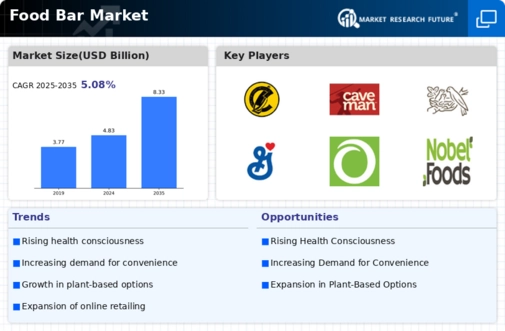Market Share
Food bar Market Share Analysis
In the rapidly expanding Food Bar Market, companies implement various market share positioning strategies to navigate the dynamic landscape shaped by changing consumer preferences and lifestyle trends. With a surge in demand for convenient and nutritious on-the-go snack options, food bars have become a staple in the modern diet. To establish and enhance their market share, companies strategically approach product development, pricing, distribution, marketing, and innovation. Product differentiation serves as a cornerstone in the Food Bar Market. Companies invest in research and development to create unique and appealing food bar offerings that stand out in a crowded market. This may involve formulating bars with diverse and exotic ingredients, catering to specific dietary preferences such as gluten-free, vegan, or keto. By offering innovative and differentiated products, companies aim to capture the attention of consumers seeking convenient and health-conscious snack solutions. Pricing strategies play a pivotal role in market share positioning. Some companies adopt a competitive pricing approach, aiming to capture a larger market share by providing affordable food bars accessible to a broad consumer base. This strategy is often suitable for mainstream or mass-market bars. Conversely, premium pricing strategies may be applied for bars emphasizing high-quality, organic ingredients, specialized nutrition, or unique flavor profiles. This approach targets consumers willing to pay a premium for perceived added value and superior nutritional benefits. Distribution channels are significant factors in market share positioning within the Food Bar Market. Establishing strong relationships with retailers, supermarkets, convenience stores, and online platforms ensures widespread availability of food bar products. Exclusive partnerships with key players in the retail industry can provide a competitive advantage, securing prominent shelf space and visibility for specific food bar brands. Marketing and branding initiatives play a pivotal role in creating a strong market presence. Companies invest in building brand identities that convey the nutritional benefits, taste, and convenience of their food bars. Marketing campaigns that highlight the bars' suitability for various dietary needs, such as post-workout, meal replacement, or snacking, can resonate with consumers. Effective use of digital marketing, social media, and collaborations with influencers or fitness experts contribute to increased brand awareness, establishing credibility and, subsequently, market share. Innovation in flavors, formulations, and packaging is another key strategy for market share positioning. Companies explore new ingredient combinations, functional additives, and sustainable packaging solutions to address evolving consumer preferences. Innovations that align with current health trends, such as protein-packed, low-sugar, or plant-based options, can set a company apart in the market and contribute to increased market share. Collaborations and partnerships within the industry are strategic moves to strengthen market share in the Food Bar Market. Companies may collaborate with nutritionists, fitness influencers, or wellness brands to co-create bars tailored to specific health goals or dietary plans. Additionally, partnerships with sports events, gyms, or wellness retreats can lead to exclusive product launches or promotions, enhancing a brand's visibility and market share. Continuous monitoring of consumer trends is essential for adapting market share positioning strategies. The Food Bar Market is influenced by evolving dietary preferences, health-conscious choices, and lifestyle trends. Companies that stay attuned to these changes can adjust their strategies accordingly, ensuring that their food bar offerings remain relevant and appealing to a diverse consumer base.













Leave a Comment